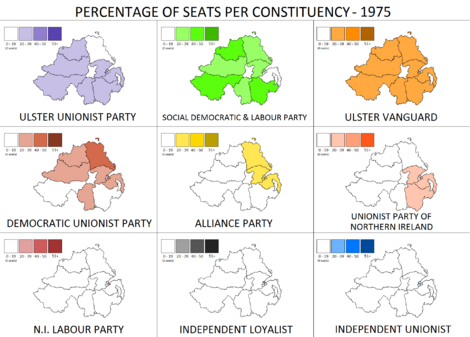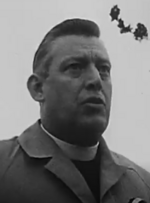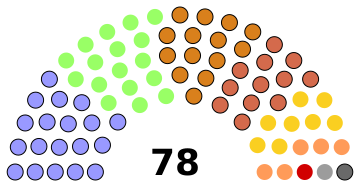Northern Ireland Constitutional Convention facts for kids
Quick facts for kids Northern Ireland Constitutional Convention |
|
|---|---|
| Type | |
| Type | |
| History | |
| Established | 1 May 1975 |
| Disbanded | 6 March 1976 |
| Preceded by | Northern Ireland Assembly (1973) |
| Succeeded by | Northern Ireland Assembly (1982) |
| Seats | 78 |
| Elections | |
| STV | |
The Northern Ireland Constitutional Convention (NICC) was a special group of elected people. It was set up in 1975 by the UK government, led by Harold Wilson and the Labour Party. Its main goal was to try and solve big political problems in Northern Ireland.
Contents
Why the Convention Was Formed
The idea for this special meeting first came from the Northern Ireland Office in a government report. This report, called The Northern Ireland Constitution, was published in July 1974. It suggested holding elections for a group that would try to agree on a political plan for Northern Ireland.
These ideas became law with the Northern Ireland Act 1974. Lord Chief Justice Robert Lowry, a very important judge, was chosen to lead the new group. Elections for the Convention were then announced for May 1, 1975.
The Convention would have 78 members. They were elected using a system called proportional representation. This system helps make sure that the number of seats a party gets is similar to the number of votes they receive. At first, the Convention was only meant to give advice. But people hoped it could eventually take on more power to make laws for Northern Ireland. This process is called devolution.
Who Was Elected to the Convention
In the elections, groups who wanted Northern Ireland to remain part of the UK, known as Unionists, joined together. They formed a group called the United Ulster Unionist Council (UUUC). This group won the most seats, getting 46 out of 78.
|
||||||||||||||||||||||||||||||||||||||||||||||||||||||||||||||||||||||||||||||||||||||||||||||||||||||||||||||||||||||||||||||||||
|
|
||||||||||||||||||||||||||||||||||||||||||||||||||||||||||||||||||||||||||||||||||||||||||||||||||||||||||||||||||||||||||||||||||
|
All 78 seats to the Northern Ireland Constitutional Convention 40 seats were needed for a majority |
||||||||||||||||||||||||||||||||||||||||||||||||||||||||||||||||||||||||||||||||||||||||||||||||||||||||||||||||||||||||||||||||||
|---|---|---|---|---|---|---|---|---|---|---|---|---|---|---|---|---|---|---|---|---|---|---|---|---|---|---|---|---|---|---|---|---|---|---|---|---|---|---|---|---|---|---|---|---|---|---|---|---|---|---|---|---|---|---|---|---|---|---|---|---|---|---|---|---|---|---|---|---|---|---|---|---|---|---|---|---|---|---|---|---|---|---|---|---|---|---|---|---|---|---|---|---|---|---|---|---|---|---|---|---|---|---|---|---|---|---|---|---|---|---|---|---|---|---|---|---|---|---|---|---|---|---|---|---|---|---|---|---|---|---|
|
||||||||||||||||||||||||||||||||||||||||||||||||||||||||||||||||||||||||||||||||||||||||||||||||||||||||||||||||||||||||||||||||||

Percentage of seats gained by each of the party.
|
||||||||||||||||||||||||||||||||||||||||||||||||||||||||||||||||||||||||||||||||||||||||||||||||||||||||||||||||||||||||||||||||||
|
||||||||||||||||||||||||||||||||||||||||||||||||||||||||||||||||||||||||||||||||||||||||||||||||||||||||||||||||||||||||||||||||||
| 19 | 17 | 14 | 12 | 8 | 5 | 3 |
| UUP | SDLP | Vanguard | DUP | APNI | UPNI | Oth |
How People Voted
This chart shows the percentage of votes each main party received:
| Popular vote | ||||
|---|---|---|---|---|
| Ulster Unionist | 25.4% | |||
| SDLP | 23.7% | |||
| DUP | 14.8% | |||
| Vanguard | 12.7% | |||
| Alliance | 9.8% | |||
| Unionist Party NI | 7.7% | |||
| Republican Clubs | 2.2% | |||
| NI Labour | 1.4% | |||
| Ind. Loyalist (UUUC) | 0.9% | |||
| Other | 1.4% | |||
How Seats Were Won
This chart shows how many seats each main party won in the Convention:
| Parliamentary seats | ||||
|---|---|---|---|---|
| Ulster Unionist | 24.4% | |||
| SDLP | 21.8% | |||
| Vanguard | 17.9% | |||
| DUP | 15.4% | |||
| Alliance | 10.3% | |||
| Unionist Party NI | 6.4% | |||
| NI Labour | 1.3% | |||
| Ind. Loyalist (UUUC) | 1.3% | |||
| Ind. Unionist | 1.3% | |||
Important Members of the Convention
Many important politicians from Northern Ireland were elected to the NICC. This made people hopeful that the Convention could achieve its goals. Some younger people who later became key figures in Northern Ireland politics were also elected. These included:
- Glenn Barr – VUPP
- Lord Brookeborough – UPNI
- William Craig – VUPP
- Austin Currie – SDLP
- Reg Empey – VUPP
- Brian Faulkner – UPNI
- Gerry Fitt – SDLP
- John Hume – SDLP
- James Kilfedder – UUP
- Seamus Mallon – SDLP
- Oliver Napier – APNI
- Ian Paisley – DUP
- Martin Smyth – UUP
- John Taylor – UUP
- David Trimble – VUPP
- Harry West – UUP
What Happened at the Convention
The election results made the Convention's job very difficult from the start. The Unionist parties who were against "power-sharing" had won the most seats. Power-sharing means that different political groups, even those who disagree, work together in government.
Because of this, the Convention's report, published in November 1975, suggested going back to the old system. This system was called "majority rule," where the party with the most seats governed alone. This idea was completely unacceptable to the nationalist parties, who wanted to share power. So, the Convention was put on hold.
The report said that no country should be forced to have people in its government who oppose the country's very existence.
Hoping to still achieve something, Secretary of State for Northern Ireland Merlyn Rees announced that the Convention would meet again in February 1976. However, meetings between the UUUC (Unionists) and the SDLP (Social Democratic and Labour Party) failed to agree on the SDLP being part of the government.
Because no agreement could be reached, Merlyn Rees announced that the Convention would be closed down on March 4, 1976. Northern Ireland then remained under direct rule from London.
Why the Convention Was Important
At first glance, the Northern Ireland Constitutional Convention seemed like a complete failure. It didn't reach an agreement between the different sides. It also didn't lead to "rolling devolution," which was a plan for gradually giving more power to Northern Ireland.
However, the Convention showed something important. It came after the Conservative government's Sunningdale Agreement, which also tried to set up power-sharing. The Convention's failure made it clear that the British government would not allow Northern Ireland to go back to simple majority rule. They wanted a solution that included both sides.
During the debates, William Craig, a Unionist leader, actually accepted the idea of power-sharing with the SDLP. This caused a split within the UUUC and led to the eventual end of his party, Vanguard.
The idea of electing a group to work out a deal for devolution was not forgotten. In 1996, a similar body called the Northern Ireland Forum was elected. This Forum was part of the process that led to the historic Good Friday Agreement and the creation of the current Northern Ireland Assembly.



